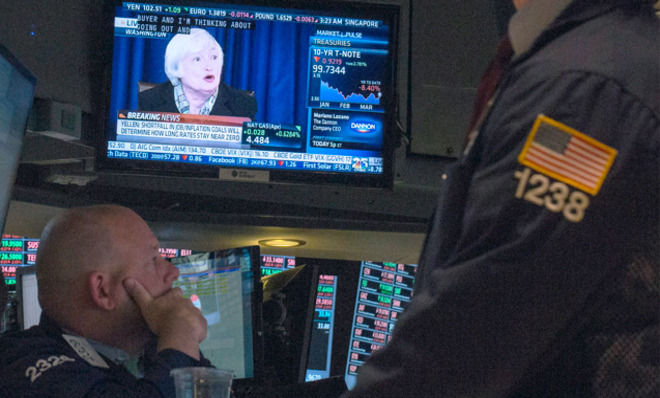No, the government isn't lying about inflation
Conspiracy theorists gonna conspiracy theorize

A claim that you hear disturbingly often in the world of financial news is that inflation is higher than the official number produced by the government.
For many, it is an appealing argument. Inflation is calculated by looking at the changes in price of a representative range of goods. In the real world, price changes are different for everyone, because no two people buy the exact same things. That means some people are going to experience a higher level of inflation than the average.
Just ask Sarah Palin, who once backed her assertion of runaway inflation with the following anecdote: "Everyone who ever goes out shopping for groceries knows that prices have risen significantly over the past year or so."
The Week
Escape your echo chamber. Get the facts behind the news, plus analysis from multiple perspectives.

Sign up for The Week's Free Newsletters
From our morning news briefing to a weekly Good News Newsletter, get the best of The Week delivered directly to your inbox.
From our morning news briefing to a weekly Good News Newsletter, get the best of The Week delivered directly to your inbox.
If you’re paying more for food than you used to, it’s easy to worry about inflation, even if rising food and energy costs are not necessarily a sign of high inflation. While inflation has actually remained below the Federal Reserve’s target of 2 percent per year, lots of people think it’s much higher — 39 percent of respondents to a Business Insider poll last year thought it was above 5 percent, for example.
It’s a narrative that’s regularly pushed by public figures like Peter Schiff and Marc Faber (and others in what Noah Smith calls the Finance Macro Canon) on CNBC. They are critics of the Federal Reserve’s bond-buying policies, and believe that such "money printing" measures will inevitably lead to high inflation, or even hyperinflation. Here’s Peter Schiff last year saying that hyperinflation is already here. Here’s Marc Faber in 2009 saying that the U.S. economy will experience Zimbabwe-style hyperinflation.
Well, the Fed's quantitative easing program has been in place for a good five years, and we still aren't transporting our cash in wheelbarrows. It's clear that these individuals are suffering from confirmation bias — they have a belief that massive inflation is coming, so they look for evidence of high inflation, while discarding evidence of low inflation. Since most of the evidence points to low inflation, they are prepared to allege that the government is lying.
Some economists, like Shadowstats’ John Williams, note that the inflation measurers at the Bureau of Labor Statistics changed their methodology in the 1980s and 1990s, and claim that if we were using the original methodology, the level of inflation would be much higher. Shadowstats presents figures that it claims to be calculations based on the original methodology.
A free daily email with the biggest news stories of the day – and the best features from TheWeek.com
But Shadowstats is not doing that. All Shadowstats is doing is taking the data from the Consumer Price Index (CPI) — the government's main gauge of inflation — and adding an arbitrary constant to make it look like inflation is higher. This should be obvious from the Shadowstats' data, which has the exact same curve as the CPI data but at a higher level. In fact, according to James Hamilton of Econbrowser, John Williams admitted in 2008 that his numbers are just inflated CPI data. So Williams is actually rigging the numbers, precisely what he accuses the government of doing! It’s like Unskewed Polls for the economy.
Given that Williams is also a hyperinflationist like Schiff and Faber — here’s Williams in 2009 saying the U.S. should prepare for a hyperinflationary depression — it would appear that Williams is also suffering from confirmation bias.
Another line of thought is that the government is intentionally lying about inflation to save money. This piece from January by Shane Obata-Marusic argues that inflation is intentionally underestimated because it is tied to cost of living adjustments for Social Security, federal civilian and military retirement pay, and Supplemental Security Income. And it’s true that some economists and politicians want to switch to chained CPI, which measures inflation slightly lower than CPI. But that’s not proof that the government is intentionally fiddling with the data.
It's also certainly true that the official figures for inflation are calculated by government agencies. The CPI is calculated by the Bureau of Labor Statistics, while the Personal Consumption Expenditures Index is calculated by the Bureau of Economic Analysis.
But these numbers are also independently corroborated by nongovernment economists. Researchers at MIT have constructed their own price index, the Billion Prices Project, which sucks in a much broader sample of price data via the internet. The Billion Prices Project has shown decisively over the last five years that the government’s figures are pretty accurate, and that inflation is nowhere near the levels suggested by the inflation conspiracy theorists.
John Aziz is the economics and business correspondent at TheWeek.com. He is also an associate editor at Pieria.co.uk. Previously his work has appeared on Business Insider, Zero Hedge, and Noahpinion.
-
 Political cartoons for January 3
Political cartoons for January 3Cartoons Saturday's political cartoons include citizen journalists, self-reflective AI, and Donald Trump's transparency
-
 Into the Woods: a ‘hypnotic’ production
Into the Woods: a ‘hypnotic’ productionThe Week Recommends Jordan Fein’s revival of the much-loved Stephen Sondheim musical is ‘sharp, propulsive and often very funny’
-
 ‘Let 2026 be a year of reckoning’
‘Let 2026 be a year of reckoning’Instant Opinion Opinion, comment and editorials of the day